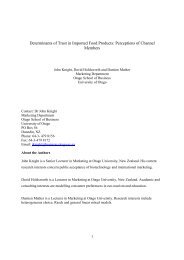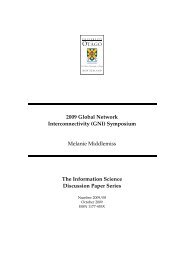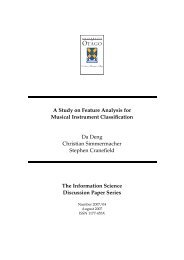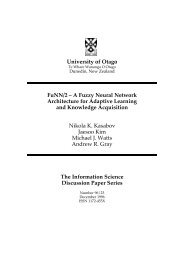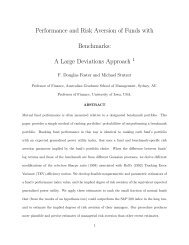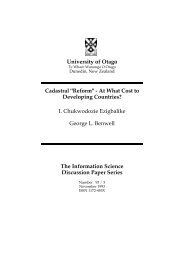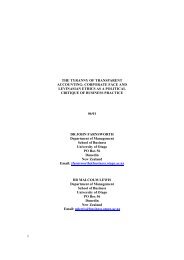Where is R2P grounded in international law? Anne-Marie Judson A ...
Where is R2P grounded in international law? Anne-Marie Judson A ...
Where is R2P grounded in international law? Anne-Marie Judson A ...
You also want an ePaper? Increase the reach of your titles
YUMPU automatically turns print PDFs into web optimized ePapers that Google loves.
Amador real<strong>is</strong>ed <strong>in</strong> the 1950s that it was no longer true that <strong>in</strong>ternational <strong>law</strong> ex<strong>is</strong>ts<br />
only for its sole ra<strong>is</strong>on d’être <strong>in</strong> the protection of the <strong>in</strong>terests and rights of the state;<br />
rather, its function was now to protect the rights and <strong>in</strong>terests of its subjects who may<br />
properly claim its protection. Th<strong>is</strong> critical analys<strong>is</strong> and understand<strong>in</strong>g of <strong>in</strong>ternational<br />
<strong>law</strong> was to become a stra<strong>in</strong> <strong>in</strong> arguments of objection to <strong>R2P</strong> <strong>in</strong> the 2005 and the<br />
2009 World Summit debates. And yet Amador had clarified these problems and<br />
arguments <strong>in</strong> <strong>in</strong>ternational <strong>law</strong> nearly 60 years before. Th<strong>is</strong> conquest <strong>in</strong> h<strong>in</strong>dsight was<br />
an <strong>in</strong>augural <strong>in</strong>troduction to how <strong>in</strong>ternational <strong>law</strong>, and the responsibility of states was<br />
go<strong>in</strong>g to codify over time. The development from the Hague Conference <strong>in</strong> 1930 69<br />
that accompl<strong>is</strong>hed some agreement on fundamental pr<strong>in</strong>ciples but ultimately ended <strong>in</strong><br />
refra<strong>in</strong><strong>in</strong>g from embody<strong>in</strong>g a def<strong>in</strong>ite formula, was a process that was go<strong>in</strong>g to<br />
cont<strong>in</strong>ue throughout the life of the debate.<br />
Amador clearly def<strong>in</strong>ed four areas of responsibility for the state. These <strong>in</strong>cluded firstly<br />
acts or om<strong>is</strong>sions of the leg<strong>is</strong>lature, judicial and executive branches. Secondly, he<br />
added acts or om<strong>is</strong>sions on the part of political subdiv<strong>is</strong>ions of a state or its colonies or<br />
other dependencies. Third, he mentioned acts or deeds committed by private persons,<br />
occurr<strong>in</strong>g dur<strong>in</strong>g <strong>in</strong>ternal d<strong>is</strong>turbances; and lastly he identified acts committed <strong>in</strong> the<br />
territory of a state by a third state or <strong>in</strong>ternational organization. The first he said<br />
<strong>in</strong>volves <strong>in</strong>ternational state responsibility, the situation vary<strong>in</strong>g accord<strong>in</strong>g to the<br />
authority that acts or omits to act. Th<strong>is</strong> may <strong>in</strong>clude leg<strong>is</strong>lative or constitutional<br />
measures that are adopted and are contrary to or <strong>in</strong>compatible with <strong>in</strong>ternational<br />
obligations to treaties and or conventions. Th<strong>is</strong> may be when the state has failed to<br />
adopt or to apply the measures that are necessary for the purpose of d<strong>is</strong>charg<strong>in</strong>g them.<br />
He clearly covers <strong>R2P</strong> <strong>in</strong> regards to obligations <strong>in</strong> <strong>in</strong>ternational customary <strong>law</strong>s,<br />
<strong>in</strong>clud<strong>in</strong>g the rules associated with Article 53 of the Vienna Convention on the Law of<br />
Treaties (1969) written nearly 12 years later, where it states that, “A treaty <strong>is</strong> void if, at<br />
the time of its conclusion, it conflicts with a peremptory norm of general <strong>in</strong>ternational<br />
<strong>law</strong>.” 70 He also recognizes that the om<strong>is</strong>sion to act <strong>is</strong> also a violation. The same <strong>is</strong><br />
mentioned <strong>in</strong> paragraph 139 of the World Summit outcome document whereby the<br />
responsibility of states to take collective action only comes after peaceful means has<br />
69 Conference for the Codification on International Law, Hague (1930) p 223 <br />
70 United Nations Document Chapter XXiii 1, volume 2, United Nations . (1969). Vienna <br />
Convention on the Law of Treaties . Vienna page 25 <br />
<br />
28




